Category: analogue
Turntables and Vinyl: Part 7
Back to Part 6
Tracking force
In order to keep the stylus tip in the groove of the record, it must have some force pushing down on it. This force must be enough to keep the stylus in the groove. However, if it is too large, then both the vinyl and the stylus will wear more quickly. Thus a balance must be found between “too much” and “not enough”.
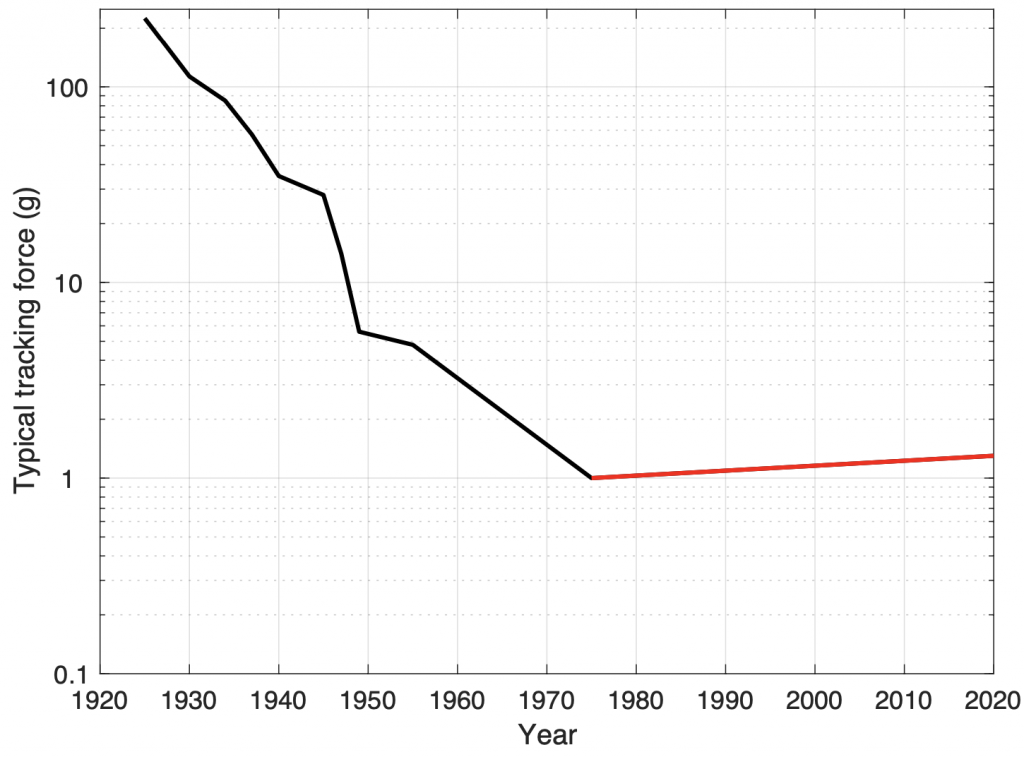
As can be seen in Figure 1, the typical tracking force of phonograph players has changed considerably since the days of gramophones playing shellac discs, with values under 10 g being standard since the introduction of vinyl microgroove records in 1948. The original recommended tracking force of the Beogram 4002 was 1 g, however, this has been increased to 1.3 g for the Beogram 4000c in order to help track more recent recordings with higher modulation velocities and displacements.
Effective Tip Mass
The stylus’s job is to track all of the vibrations encoded in the groove. It stays in that groove as a result of the adjustable tracking force holding it down, so the moving parts should be as light as possible in order to ensure that they can move quickly. The total apparent mass of the parts that are being moved as a result of the groove modulation is called the effective tip mass. Intuitively, this can be thought of as giving an impression of the amount of inertia in the stylus.
It is important to not confuse the tracking force and the effective tip mass, since these are very different things. Imagine a heavy object like a 1500 kg car, for example, lifted off the ground using a crane, and then slowly lowered onto a scale until it reads 1 kg. The “weight” of the car resting on the scale is equivalent to 1 kg. However, if you try to push the car sideways, you will obviously find that it is more difficult to move than a 1 kg mass, since you are trying to overcome the inertia of all 1500 kg, not the 1 kg that the scale “sees”. In this analogy, the reading on the scale is equivalent to the Tracking Force, and the mass that you’re trying to move is the Effective Tip Mass. Of course, in the case of a phonograph stylus, the opposite relationship is desirable; you want a tracking force high enough to keep the stylus in the groove, and an effective tip mass as close to 0 as possible, so that it is easy for the groove to move it.
Compliance
Imagine an audio signal that is on the left channel only. In this case, the variation is only on one of the two groove walls, causing the stylus tip to ride up and down on those bumps. If the modulation velocity is high, and the effective tip mass is too large, then the stylus can lift off the wall of the groove just like a car leaving the surface of a road on the trailing side of a bump. In order to keep the car’s wheels on the road, springs are used to push them back down before the rest of the car starts to fall. The same is true for the stylus tip. It’s being pushed back down into the groove by the cantilever that provides the spring. The amount of “springiness” is called the compliance of the stylus suspension. (Compliance is the opposite of spring stiffness: the more compliant a spring is, the easier it is to compress, and the less it pushes back.)
Like many other stylus parameters, the compliance is balanced with other aspects of the system. In this case it is balanced with the effective mass of the tonearm (which includes the tracking force(1), resulting in a resonant frequency. If that frequency is too high, then it can be audible as a tone that is “singing along” with the music. If it’s too low, then in a worst-case situation, the stylus can jump out of the record groove.
If a turntable is very poorly adjusted, then a high tracking force and a high stylus compliance (therefore, a “soft” spring) results in the entire assembly sinking down onto the record surface. However, a high compliance is necessary for low-frequency reproduction, therefore the maximum tracking force is, in part, set by the compliance of the stylus.
If you are comparing the specifications of different cartridges, it may be of interest to note that compliance is often expressed in one of five different units, depending on the source of the information:
- “Compliance Unit” or “cu”
- mm/N
millimetres of deflection per Newton of force - µm/mN
micrometres of deflection per thousandth of a Newton of force - x 10^-6 cm/dyn
hundredths of a micrometre of deflection per dyne of force - x 10^-6 cm / 10^-5 N
hundredths of a micrometre of deflection per hundred-thousandth of a Newton of force
Since
mm/N = 1000 µm / 1000 mN
and
1 dyne = 0.00001 Newton
Then this means that all five of these expressions are identical, so, they can be interchanged freely. In other words:
20 CU
= 20 mm / N
= 20 µm / mN
= 20 x 10^-6 cm / dyn
= 20 x 10^-6 cm / 10^-5 N
Footnotes
- On the Mechanics of Tonearms, Dick Pierce
Turntables and Vinyl: Part 6
Back to Part 5
Tip shape
The earliest styli were the needles that were used on 78 RPM gramophone players. These were typically made from steel wire that was tapered to a conical shape, and then the tip was rounded to a radius of about 150 µm, by tumbling them in an abrasive powder.(1) This rounded curve at the tip of the needle had a hemispherical form, and so styli with this shape are known as either conical or spherical.
The first styli made for “microgroove” LP’s had the same basic shape as the steel predecessor, but were tipped with sapphire or diamond. The conical/spherical shape was a good choice due to the relative ease of manufacture, and a typical size of that spherical tip was about 36 µm in diameter. However, as recording techniques and equipment improved, it was realised that there are possible disadvantages to this design.
Remember that the side-to-side shape of the groove is a physical representation of the audio signal: the higher the frequency, the smaller the wave on the disc. However, since the disc has a constant speed of rotation, the speed of the stylus relative to the groove is dependent on how far away it is from the centre of the disc. The closer the stylus gets to the centre, the smaller the circumference, so the slower the groove speed.
If we look at a 12″ LP, the smallest allowable diameter for the modulated groove is about 120 mm, which gives us a circumference of about 377 mm (or 120 * π). The disc is rotating 33 1/3 times every minute which means that it is making 0.56 of a rotation per second. This, in turn, means that the stylus has a groove speed of 209 mm per second. If the audio signal is a 20,000 Hz tone at the end of the recording, then there must be 20,000 waves carved into every 209 mm on the disc, which means that each wave in the groove is about 0.011 mm or 11 µm long.
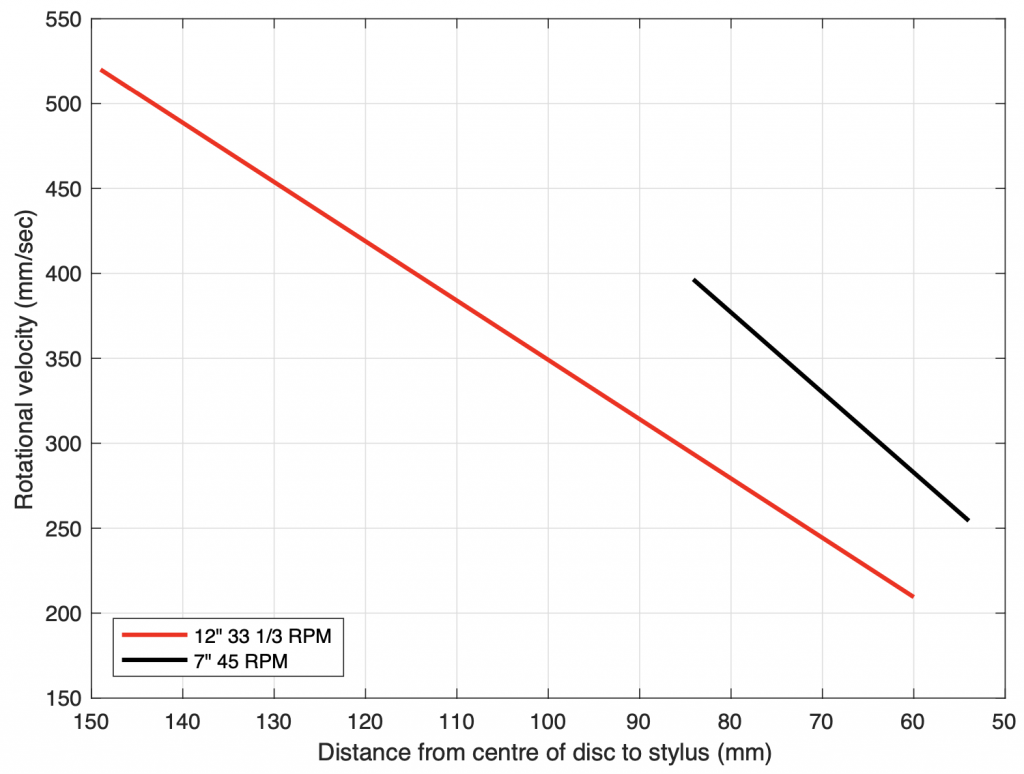
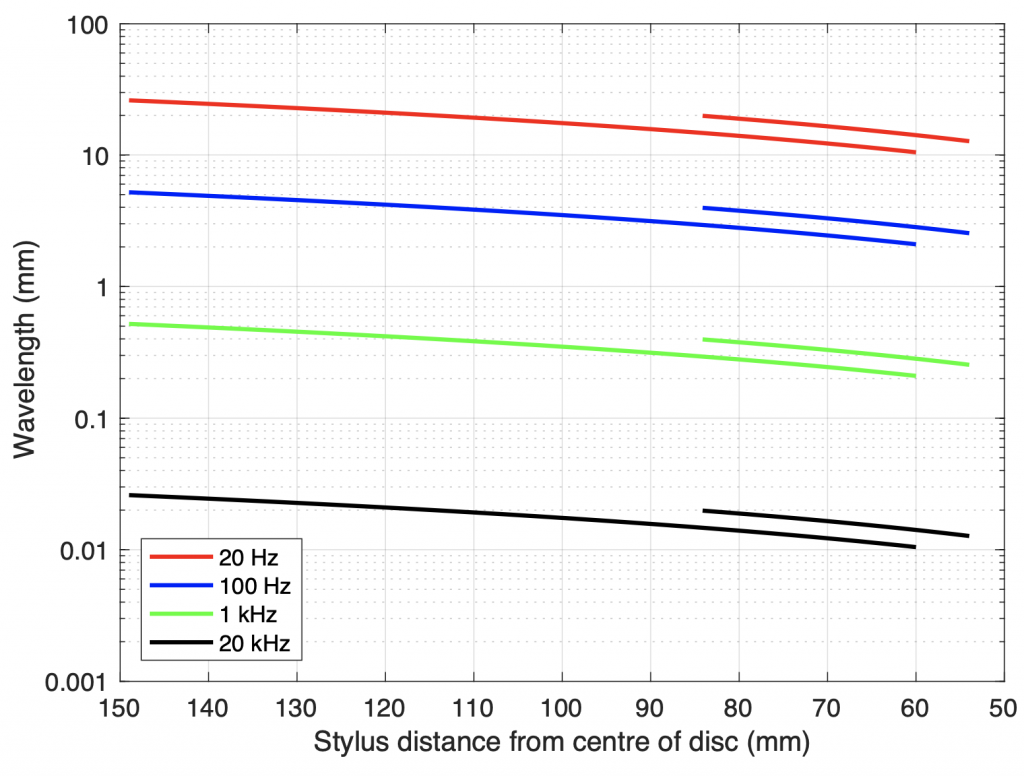
However, now we have a problem. If the “wiggles” in the groove have a total wavelength of 11 µm, but the tip of the stylus has a diameter of about 36 µm, then the stylus will not be able to track the groove because it’s simply too big (just like the tires of your car do not sink into every small crack in the road). Figure 3 shows to-scale representations of a conical stylus with a diameter of 36 µm in a 70 µm-wide groove on the inside radius of a 33 1/3 RPM LP (60 mm from the centre of the disc), viewed from above. The red lines show the bottom of the groove and the black lines show the edge where the groove meets the surface of the disc. The blue lines show the point where the stylus meets the groove walls. The top plot is a 1 kHz sine wave and the bottom plot is a 20 kHz sine wave, both with a lateral modulation velocity of 70 mm/sec. Notice that the stylus is simply too big to accurately track the 20 kHz tone.
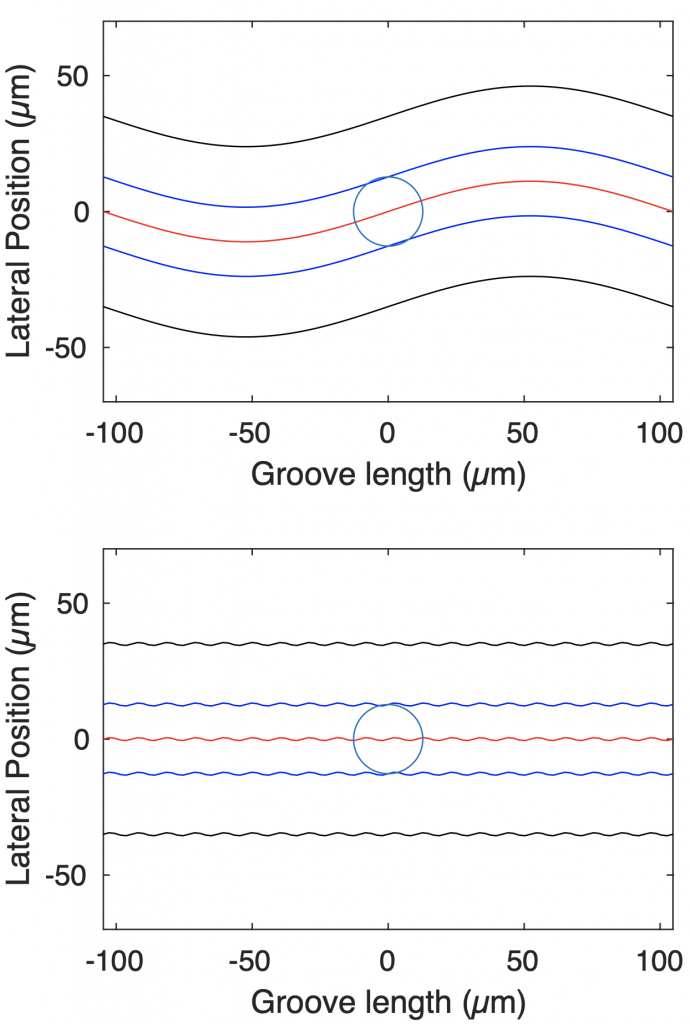
One simple solution was to “sharpen” the stylus; to make the diameter of the spherical tip smaller. However, this can cause two possible side effects. The first is that the tip will sink deeper into the groove, making it more difficult for it to move independently on the two audio channels. The second is that the point of contact between the stylus and the vinyl becomes smaller, which can result in more wear on the groove itself because the “footprint” of the tip is smaller. However, since the problem is in tracking the small wavelength of high-frequency signals, it is only necessary to reduce the diameter of the stylus in one dimension, thus making the stylus tip elliptical instead of conical. In this design, the tip of the stylus is wide, to sit across the groove, but narrow along the groove’s length, making it small enough to accurately track high frequencies. An example showing a 0.2 mil x 0.7 mil (10 x 36 µm) stylus is shown in Figure 4. Notice that this shape can track the 20 kHz tone more easily, while sitting at the same height in the groove as the conical stylus in Figure 3.
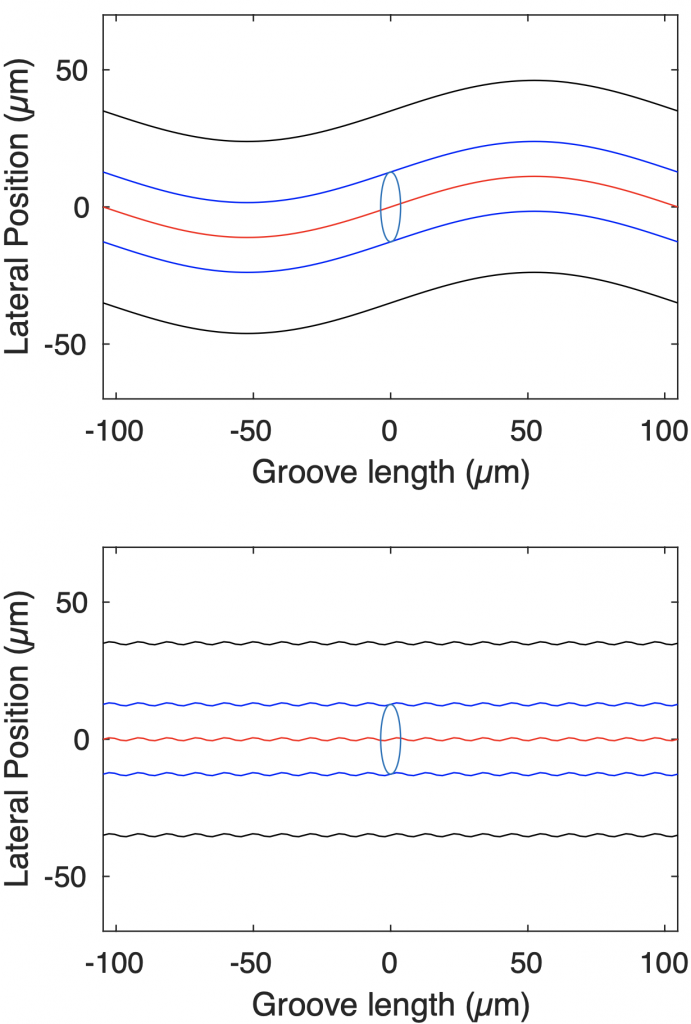
Both the conical and the elliptical stylus designs have a common drawback in that the point of contact between the tip and the groove wall is extremely small. This can be seen in Figure 5, which shows various stylus shapes from the front. Notice the length of the contact between the red and black lines (the stylus and the groove wall). As a result, both the groove of the record and the stylus tip will wear over time, generally resulting in an increasing loss of high frequency output. This was particularly a problem when the CD-4 Quadradisc format was introduced, since it relies on signals as high as 45 kHz being played from the disc.(2) In order to solve this problem, a new stylus shape was invented by Norio Shibata at JVC in 1973. The idea behind this new design is that the sides of the stylus are shaped to follow a much larger-radius circle than is possible to fit into the groove, however, the tip has a small radius like a conical stylus. An example showing this general concept can be seen on the right side of Figure 5.

There have been a number of different designs following Shibata’s general concept, with names such as MicroRidge (which has an interesting, almost blade-like shape “across” the groove), Fritz-Geiger, Van-den-Hul, and Optimized Contour Contact Line. Generally, these designs have come to be known as line contact (or contact line) styli, because the area of contact between the stylus and the groove wall is a vertical line rather than a single point.
In 1973, Bang and Olufsen started working its own turntable that could play the new CD-4 Quadradisc format. This not only meant developing a new decoder with a 4-channel output, but also a stylus with a bandwidth reliably extending to approximately 45 kHz. This task was given to Villy Hansen, who was project manager for pickup development, despite being still relatively new to the company. Hansen proposed an improvement upon the Shibata grind (which was already commercially available by then) by making 4 facets instead of 2, resulting in a better shape for tracking the very high-frequency modulation. Although developed by Hansen, the new stylus became known as the “Pramanik diamond”, named after Subir K. Pramanik, who had started working as an engineer in Struer in 1971, but who had temporarily returned to India. The end result was a new pickup family that was initially launched with the top model, the MMC 6000.
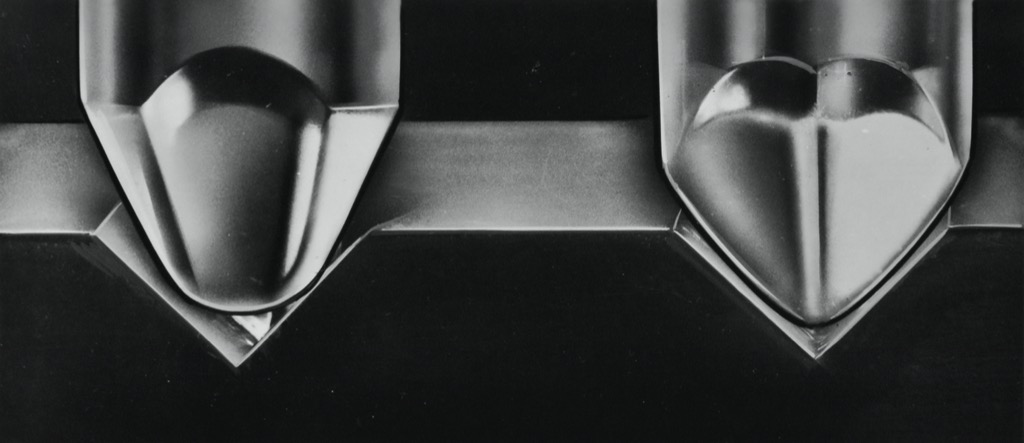
Bonded vs. Nude
There is one small, but important point regarding a stylus’s construction. Although the tip of the stylus is almost always made of diamond today, in lower-cost units, that diamond tip is mounted or bonded to a titanium or steel pin which is, in turn, connected to the cantilever (the long “arm” that connects back to the cartridge housing). This bonded design is cheaper to manufacture, but it results in a high mass at the stylus tip, which means that it will not move easily at high frequencies.

In order to reduce mass, the steel pin is eliminated, and the entire stylus is made of diamond instead. This makes things more costly, but reduces the mass dramatically, so it is preferred if the goal is higher sound performance. This design is known as a nude stylus.
Footnotes
- See “The High-fidelity Phonograph Transducer” B.B. Bauer, JAES 1977 Vol 25, Number 10/11, Oct/Nov 1977
- The CD4 format used a 30 kHz carrier tone that was frequency-modulated ±15 kHz. This means that the highest frequency that should be tracked by the stylus is 30 kHz + 15 kHz = 45 kHz.
On to Part 7
Turntables and Vinyl: Part 5
Back to Part 4
Before we go any further, we need to just collect a bunch of information about vinyl records.
General Information
Min groove depth: 0.001″ = 0.039 µm
Max groove depth: 0.005″ = 0.197 µm
12″ LP’s
Outside modulation groove radius: 146 mm
Inside modulation groove radius: 60 mm
Total maximum modulation radius: 86 mm (3.4″)
Typical modulation radius: 76 mm (3″)
7″ 45 RPM
Outside modulation groove radius: 84 mm
Inside modulation groove radius: 54 mm
Total maximum modulation radius: 30 mm (1.2″)
Basic math
Pitch = (Running time x RPM) / Modulation Radius
Groove Width = (1000/LPI + 1) / 2
Peak Amplitude of Displacement = Peak Lateral Velocity / (2 π freq)
Examples
Pitch = (Running time x RPM) / Modulation Radius
Pitch = (20 minutes x 33.333) / 76 mm
Pitch = 8.8 lines per mm (LPm) = 223 LPI
Groove Width = (1000/LPI + 1) / 2
Groove Width = (1000/223 + 1) / 2
Groove Width = 2.74 mil = 2.74 x 10^-3 inches = 0.0697 mm
Peak Amplitude of Displacement = Peak Lateral Velocity / (2 π freq)
Peak Amplitude of Displacement = 70 mm/sec / (2 π 1000)
Peak Amplitude of Displacement = 0.011 mm
Reference:
“Basic Disc Mastering” by Larry Boden (1981)
On to Part 6
Turntables and Vinyl: Part 4
Back to Part 3
MMC: Micro Moving Cross
As mentioned above, when a wire is moved through a magnetic field, a current is generated in a wire that is proportional to the velocity of the movement. In order to increase the output, the wire can be wrapped into a coil, effectively lengthening the piece of wire moving through the field. Most phono cartridges make use of this behaviour by using the movement of the stylus to either:
- move tiny magnets that are placed near coils of wire (a Moving Magnet or MM design
or - move tiny coils of wire that are placed near very strong magnets (a Moving Coil or MC design)
In either system, there is a relative physical movement that is used to generate the electrical signal from the cartridge. There are advantages and disadvantages associated with both of these systems, however, they’re well-discussed in other places, so I won’t talk about them here.
There is a third, less common design called a Moving Iron (or variable-reluctance(1)) system, which can be thought of as a variant of the Moving Magnet principle. In this design, the magnet and the coils remain stationary, and the stylus moves a small piece of iron instead. That iron is placed between the north and south poles of the magnet so that, when it moves, it modulates (or varies) the magnetic field. As the magnetic field modulates, it moves relative to the coils, and an electrical signal is generated. One of the first examples of this kind of pickup was the Western Electric 4A reproducer made in 1925.
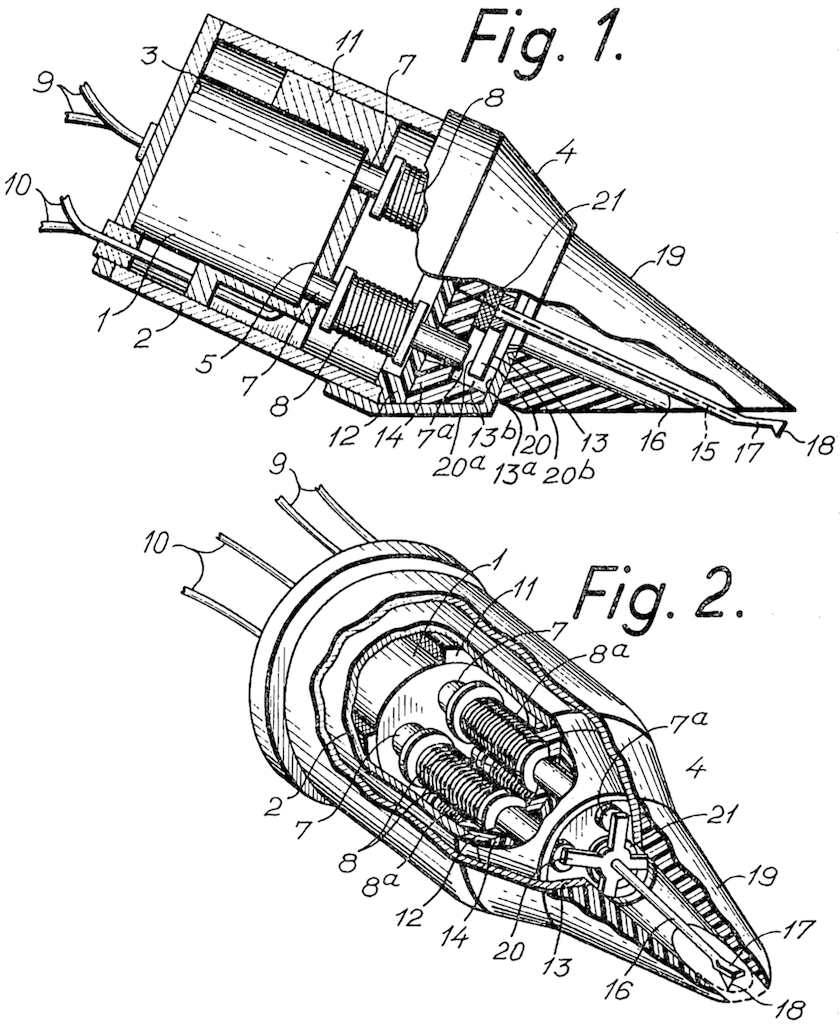
In 1963, Erik Rørbaek Madsen of Bang & Olufsen filed a patent for a cartridge based on the Moving Iron principle. In it, a cross made of Mu-metal is mounted on the stylus. Each arm of the cross is aligned with the end of a small rod called a “pole piece” (because it was attached to the pole of a magnet on the opposite end). The cross is mounted diagonally, so the individual movements of the left and right channels on the groove cause the arms of the cross to move accordingly. For a left-channel signal, the bottom left and top right cross arms move in opposite directions – one forwards and one backwards. For a right-channel signal, the bottom right and top left arms move instead. The two coils that generate the current for each audio channel are wired in a push-pull relationship.
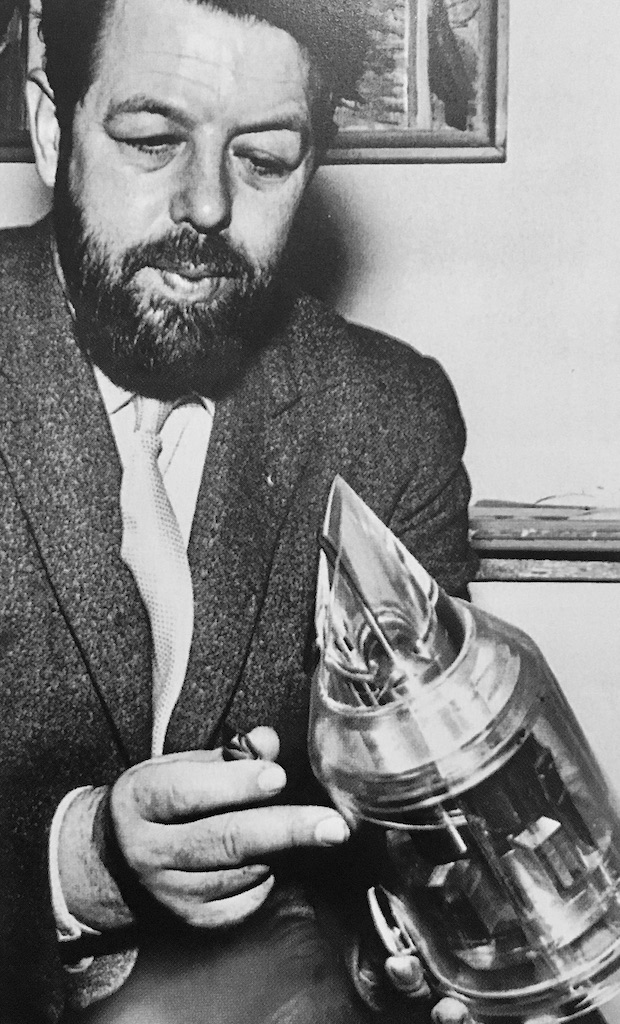
There are a number of advantages to this system over the MM and MC designs. Many of these are described in the original 1963 patent, as follows:
- “The channel separation is very good and induction of cross talk from one channel to the other is minimized because cross talk components are in phase in opposing coils.”
- “The moving mass which only comprises the armature and the stylus arm can be made very low which results in good frequency response.”
- “Hum pick-up is very low due to the balanced coil construction”
- “… the shielding effect of the magnetic housing … provides a completely closed magnetic circuit which in addition to shielding the coil from external fields prevents attraction to steel turntables.”
- Finally, (although this is not mentioned in the patent) the push-pull wiring of the coils “reduces harmonic distortion induced by the non-linearity of the magnetic field.”(2)
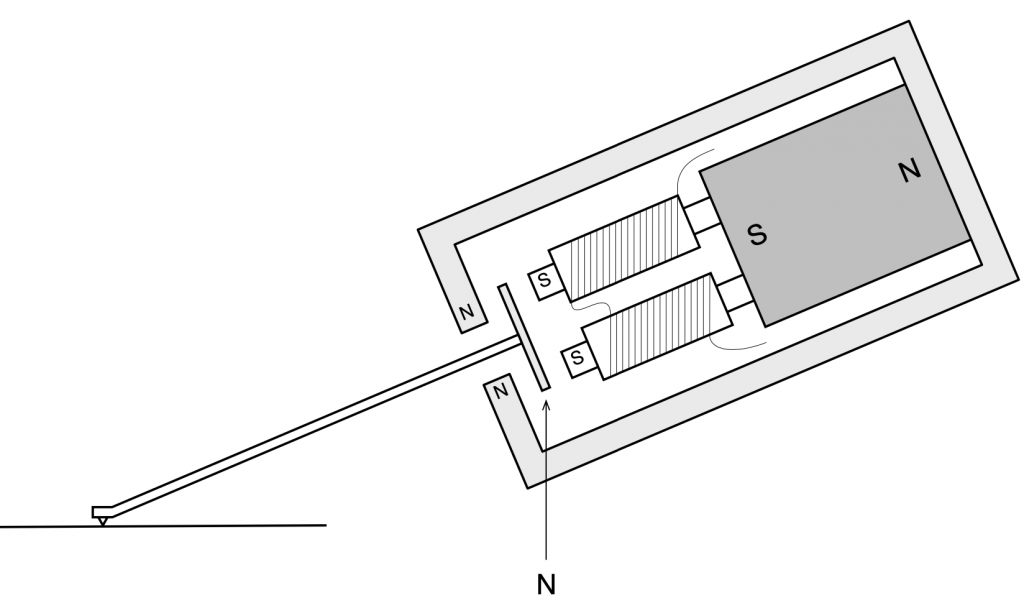
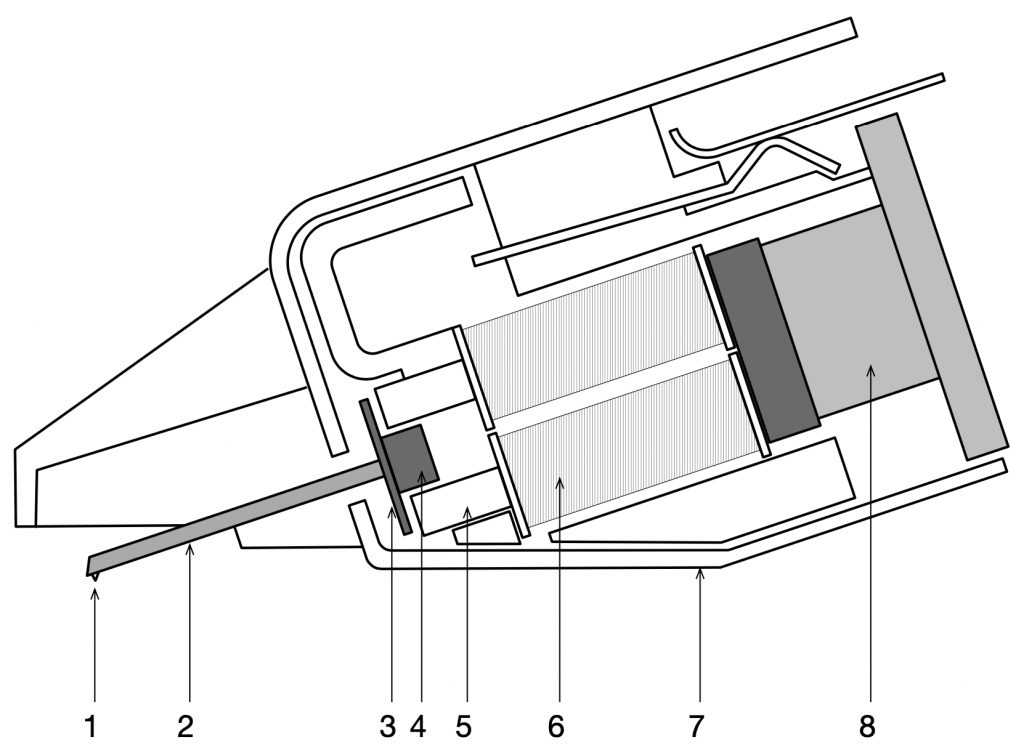
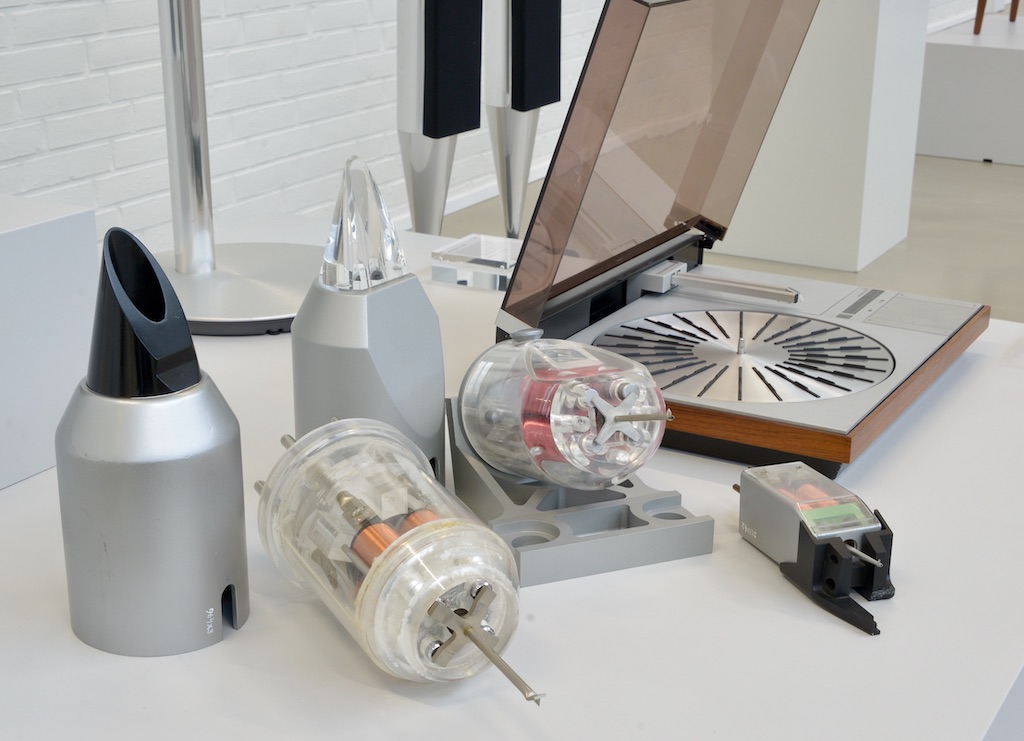
Footnotes
- reluctance is the magnetic equivalent of electrical resistance
- “Sound Recording Handbook”, ed. Glen Ballou
Turntables and Vinyl: Part 3
Back to Part 2
Signal Levels
Every audio device relies on a rather simple balancing act. The “signal”, whether it’s speech, music, or sound effects, should be loud enough to mask the noise that is inherent in the recording or transmission itself. The measurement of this “distance” in level is known as the Signal-to-Noise Ratio or SNR. However, the signal should not be so loud as to overload the system and cause distortion effects such as clipping, which results in what is commonly called Total Harmonic Distortion or THD.(1) One basic method to evaluate the quality of an audio signal or device is to group these two measurements into one value: the Total Harmonic Distortion plus Noise or THD+N value. The somewhat challenging issue with this value is that a portion of it (the noise floor) is typically independent of the signal level, since a device or signal will have some noise regardless of whether a signal is present or not. However, the distortion is typically directly related to the level of the signal.
In modern digital PCM audio signal (assuming that it is correctly-implemented and ignoring any additional signal processing), the noise floor is the result of the dither that is used to randomise the inherent quantisation error in the encoding system. This noise is independent of the signal level, and entirely dependent on the resolution of the system (measured in the number of bits used to encode each sample). The maximum possible level that can be encoded without incurring additional distortion that is inherent in the encoding system itself is when the maximum (or minimum) value in the audio signal reaches the highest possible signal value of the system. Any increase in the signal’s level beyond this will be clipped, and harmonic distortion artefacts will result.
Figure 1 shows two examples of the relationship between the levels of the signal and the THD+N in a digital audio system. The red line shows a 24-bit encoding, the blue line is for 16-bit. The “flat line” on the left of the plot is the result of the noise floor of the system. In this region, the signal level is so low, it’s below the noise floor of the system itself, so the only measurable output is the noise, and not the signal. As we move towards the right, the input signal gets louder and raises above the noise floor, so the output level naturally increases as well. However, in a digital audio system, we reach a maximum possible input level of 0 dB FS. If we try to increase the signal’s level above this, the signal itself will not get louder, however, it will become more and more distorted. As a result, the distortion artefacts quickly become almost as loud as the signal itself, and so the plots drop dramatically.
This is why good recording engineers typically attempt to align the levels of the microphones to ensure that the maximum peak of the entire recording will just barely reach the maximum possible level of the digital recording system. This ensures that they are keeping above the noise floor as much as possible without distorting the signals.
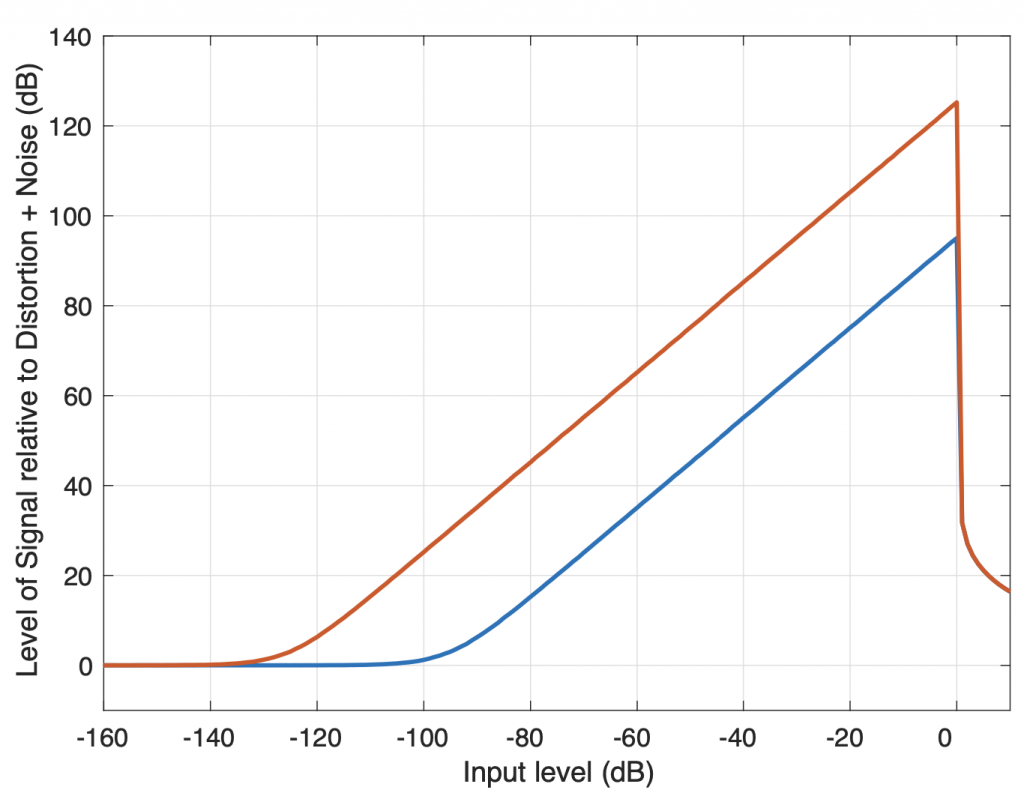
Audio signals recorded on analogue-only devices generally have the same behaviour; there is a noise floor that should be avoided and a maximum level above which distortion will start to increase. However, many analogue systems have a slightly different characteristic, as can be seen in the idealised model shown in Figure 2. Notice that, just like in the digital audio system, the noise floor is constant, and as the level of the input signal is increased, it rises above this. However, in an analogue system, the transition to a distorted signal is more gradual, seen as the more gentle slopes of the curves on the right side of the graph.

As a result, in a typical analogue audio system, there is an “optimal” level that is seen to be the best compromise between the signal being loud enough above the noise floor, but not distorting too much. The question of how much distortion is “too much” can then be debated — or even used as an artistic effect (as in the case of so-called “tape compression”).
If we limit our discussion to the stylus tracking a groove on a vinyl disc, converting that movement to an electrical signal that is amplified and filtered in a RIAA-spec preamplifier, then a phonograph recording is an analogue format. This means, generally speaking, that there is an optimal level for the audio signal, which, in the case of vinyl, means a modulation velocity of the stylus, converted to an electrical voltage.
Although there are some minor differences of opinion, a commonly-accepted optimum level for the groove on a stereo recording is 35.4 mm/sec for a single audio channel at 1,000 Hz. In a case where both audio channels have the same 1 kHz signal recorded in phase (as a dual-monophonic signal), then this means that the lateral velocity of the stylus will be 50 mm/sec.(2)
Of course, the higher the modulation velocity of the stylus, the higher the output of the turntable. However, this would also mean that the groove on the vinyl disc would require more space, since it is being modulated more. This means that there is a relationship between the total playing time of a vinyl disc and the modulation velocity. In order to have 20 minutes of music on a 12” LP spinning at 33 1/3 RPM, then it the standard method was to cut 225 “lines per inch” or “LPI” (about 89 lines per centimetre) on the disc. If a mastering engineer wishes to have a signal with a higher output, then the price is a lower playing time (because the grooves much be spaced further apart to accommodate the higher modulation velocity) however, in well-mastered recordings, this spacing is varied according to the dynamic range of the audio signal. In fact, in some classical recordings, it is easy to see the louder passages in the music because the grooves are intentionally spaced further apart, as is illustrated in Figure 3.
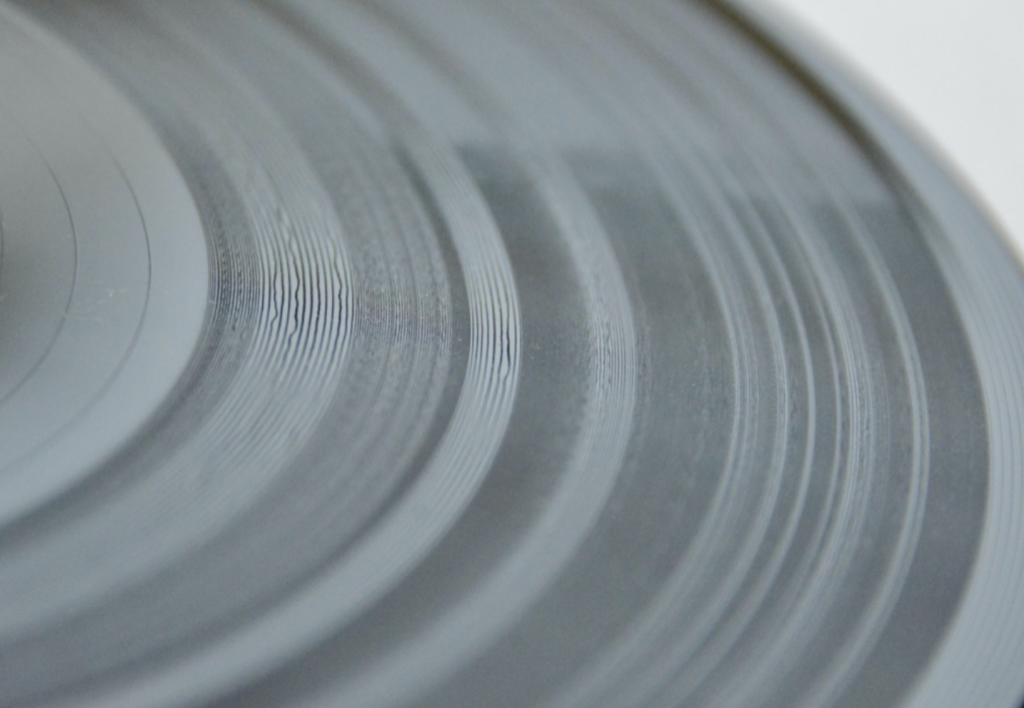
A large part of the performance of a turntable is dependent on the physical contact between the surface of the vinyl and the tip of the stylus. In general terms, as we’re already seen, there is a groove with two walls that vary in height, almost independently and the tip of the stylus traces that movement accordingly. However, it is necessary to get down to the microscopic level to consider this behaviour in more detail.
When a record is mastered (meaning, when the master disc is created on a lathe) the groove is cut by a heated stylus that has a specific shape, shown in Figure4. The depth of the groove can range from a minimum of 25 µm to a maximum of 127µm, which, in turn varies the width of the groove.(3)
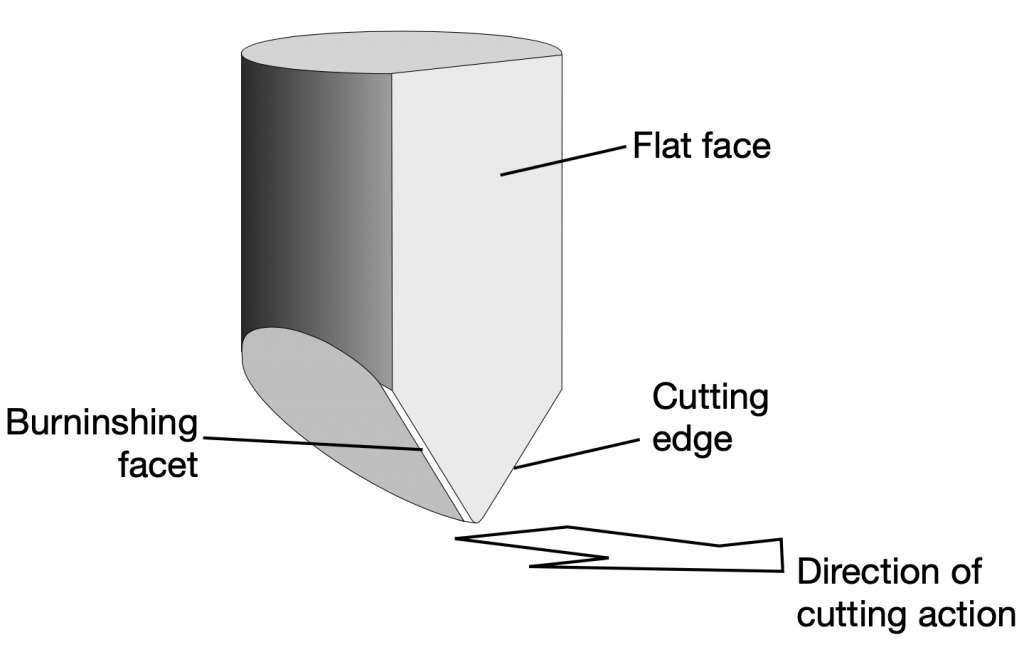
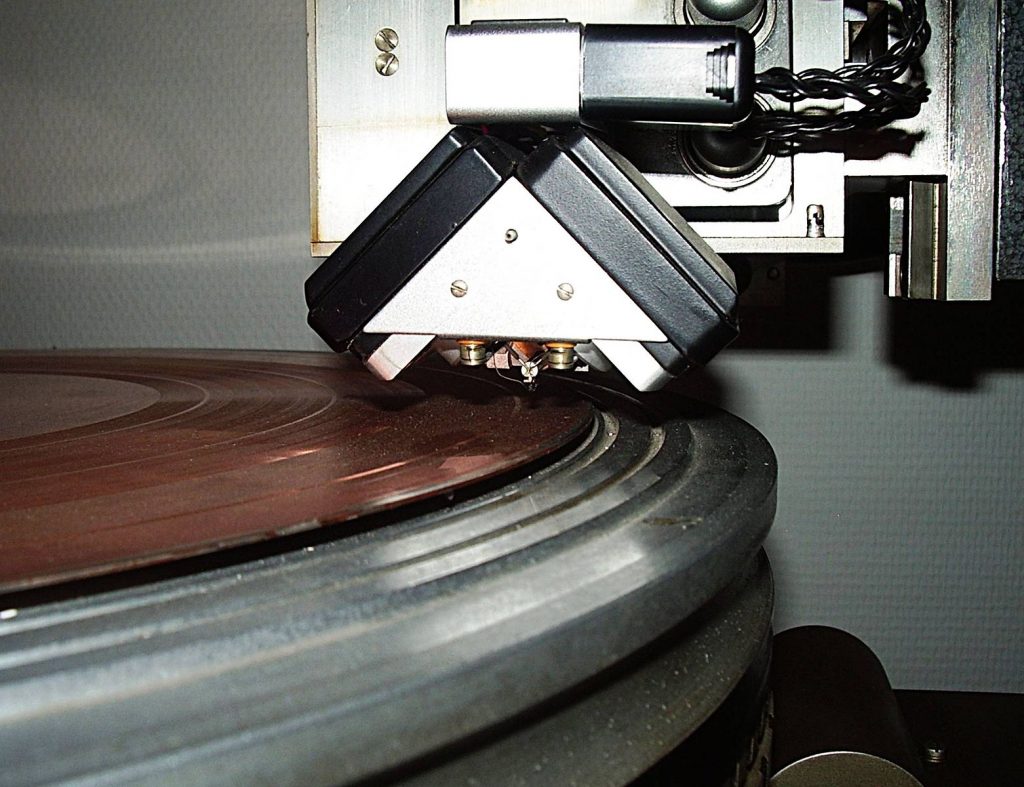

The result is a groove with a varying width and depth that are dependent on the decisions made by the mastering engineer, and a modulation displacement (the left/right size of the “wiggle”) that is dependent on the level of the audio signal that is being reproduced.
In a perfect situation, the stylus that is used to play that signal back on a turntable would have exactly the same shape as the cutting stylus, since this would mean that the groove is traced in exactly the same way that it was cut. This, however, is not practical for a number of reasons. As a result, there are a number of options when choosing the shape of the playback stylus.
Footnotes
- The assumption here is that the distortion produces harmonics of the signal, which is a simplified view of the truth, but an effect that is easy to measure.
- (35.4*2) / sqrt(2) because the two channels are modulated at an angle of 45 degrees to the surface of the disc.
- See “The High-fidelity Phonograph Transducer” B.B. Bauer, JAES 1977 Vol 25, Number 10/11, Oct/Nov 1977
On to Part 4
Turntables and Vinyl: Part 2
Back to Part 1: History
The physics
Amplitude vs. Velocity
At the end of Part 1, I mentioned that there is an interaction between magnetic fields, movement, and electrical current. This is at the heart of almost every modern turntable. As the stylus or “needle” (1) is pulled through the grove in the vinyl surface, it moves from side-to-side at a varying speed called the modulation velocity or just the velocity. An example of this wavy groove can be seen in the photo below. Inside the housing of most cartridges are small magnets and coils of wire, either of which is being moved by the stylus as it vibrates. That movement generates an electrical current that is analogous to the shape of the groove: the higher the velocity of the stylus, the higher the electrical signal from the cartridge.
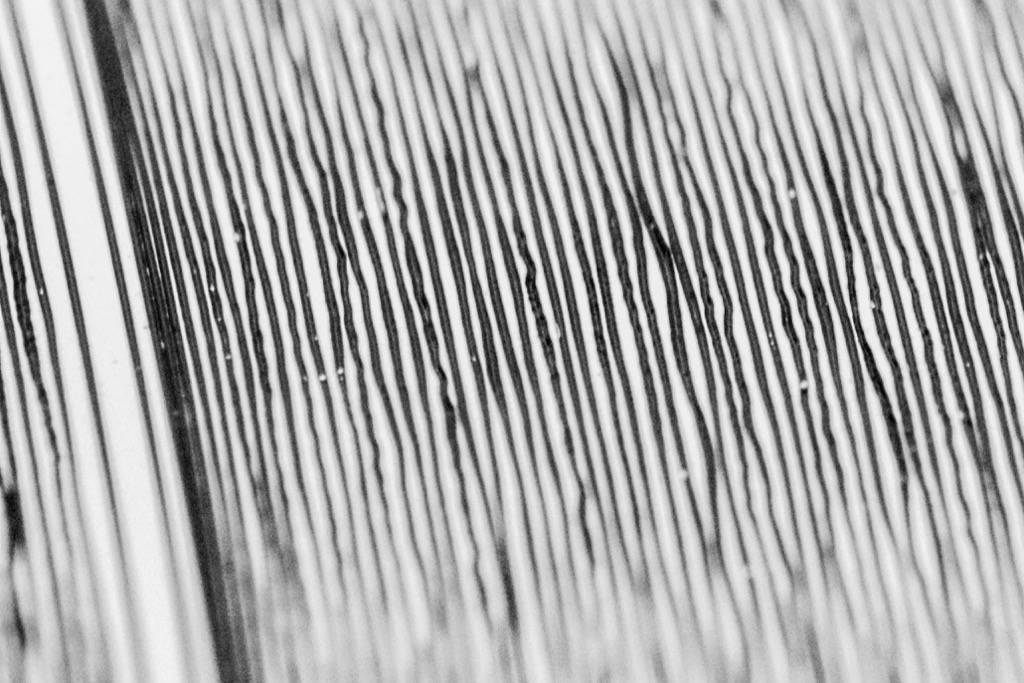
However, this introduces a problem because if the amplitude remains the same at all frequencies the modulation velocity of the stylus decreases with frequency; in other words, the lower the note, the lower the output level, and therefore the less bass. This is illustrated in the graph in Figure 2 below in which three sine waves are shown with different frequencies. The blue line shows the lowest frequency and the orange line is the highest. Notice that all three have the same amplitude (the same maximum “height”). However, if you look at the slopes of the three curves when they pass Time = 0 ms, you’ll see that the higher the frequency, the higher the slope of the line, and therefore the higher the velocity of the stylus.
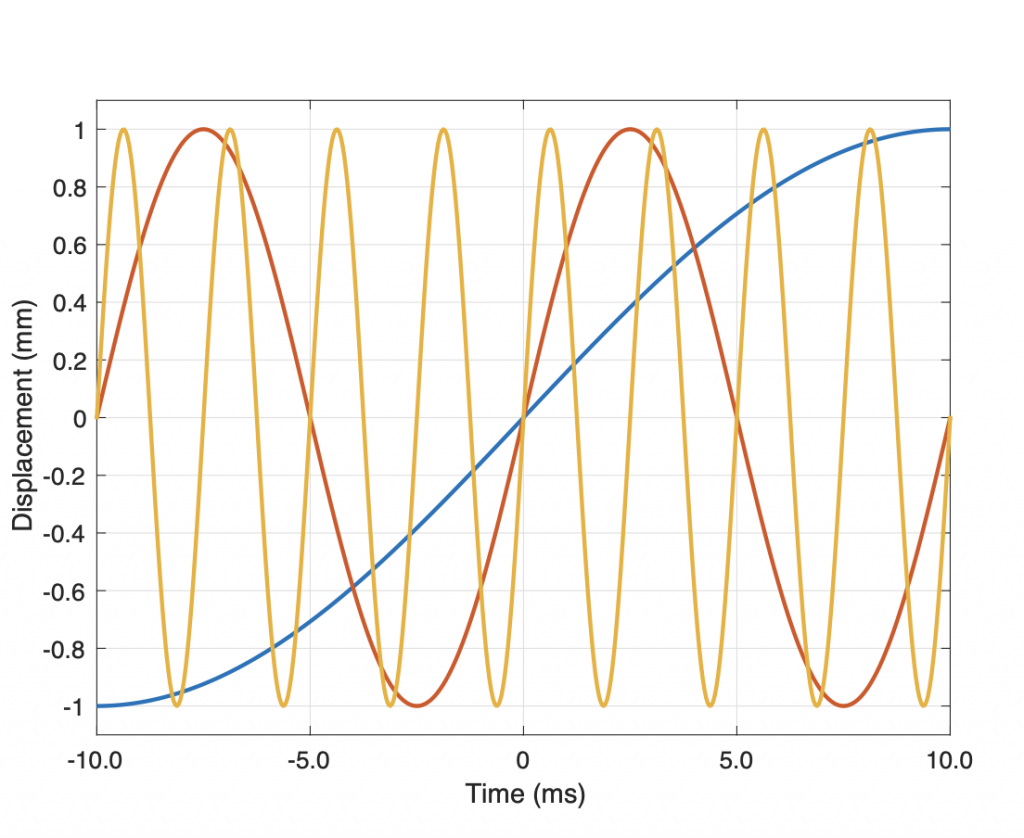
In order to achieve a naturally flat frequency response from the cartridge, where all frequencies have the same electrical output level, it is necessary to ensure that they have the same modulation velocity, as shown in Figure 3 below. In that plot, it can be seen that the slopes of the three waves are the same at Time = 0 ms. However, it is also evident that, when this is true, they have very different amplitudes: in fact, the amplitude would have to double for every halving of frequency (a drop of 1 octave). This is not feasible, since it would mean that the stylus would have to move left and right by (relatively) huge distances in order to deliver the desired output. For example, if the stylus were moving sideways by $\pm$ 0.1 mm at 1,000 Hz to deliver a signal, then it would have to move $\pm$ 1 mm at 100 Hz, and $\pm$ 10 mm at 10 Hz to deliver the same output level. This is not possible (or at least it’s very impractical).
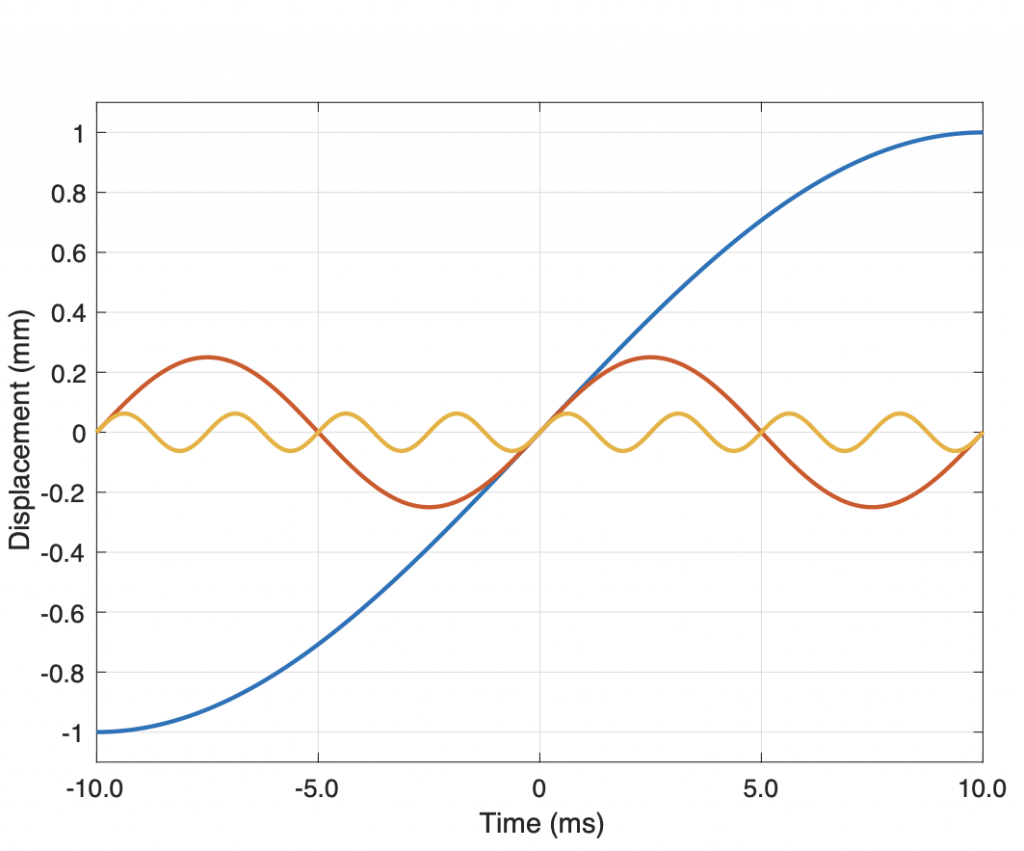
The solution for this limitation was to use low-frequency audio compensation filters, both at the recording and the playback stages. When a recording is mastered to be cut on a disc, the low frequency level is decreased; the lower the frequency, the lower the level. This results in a signal recorded on disc with a constant amplitude for signals below approximately 1 kHz.
Of course, if this signal were played back directly, there would be an increasing loss of level at lower and lower frequencies. So, to counteract this, a filter is applied to the output signal of the turntable that boosts the low frequencies signals to their original levels.
Surface noise
A second problem that exists with vinyl records is that of dust and dirt. If you look again at the photo in the first Figure at the top of this posting, you can see white specks lodged in the groove. These look very small to us, however, to the stylus, they are very large bumps that cause the tip to move abruptly, and therefore quickly. Since the output signal is still proportional to the modulation velocity, then this makes the resulting cracks and pops quite loud in relation to the audio signal.
In order to overcome this problem, a second filter is used, this time for higher frequencies. Upon playback, the level of the treble is reduced; the higher the frequency the lower the output. This reduces the problem of noise caused by surface dirt on the disc, however it would also reduce the high frequency content of the audio signal itself. This is counteracted by increasing the level of the high-frequency portion of the audio signal when it is mastered for the disc.
This general idea of lowering the level of low-frequencies and/or boosting highs when recording and doing the opposite upon playback is a very old idea in the audio industry and has been used on many formats ranging from film “talkies” to early compact discs. Unfortunately, however, different recording companies and studios used different filters on phonographs for many years. (2) Finally, in the mid-1950s, the Recording Industry Association of America (the RIAA) suggested a standard filter description with the intention that it would be used world-wide for all PVC “vinyl” records.
The two figures below show the responses of the RIAA filters used in both the mastering and the playback of long playing vinyl records. Although there are other standards with slightly different responses, the RIAA filter is by far the most commonly-used.

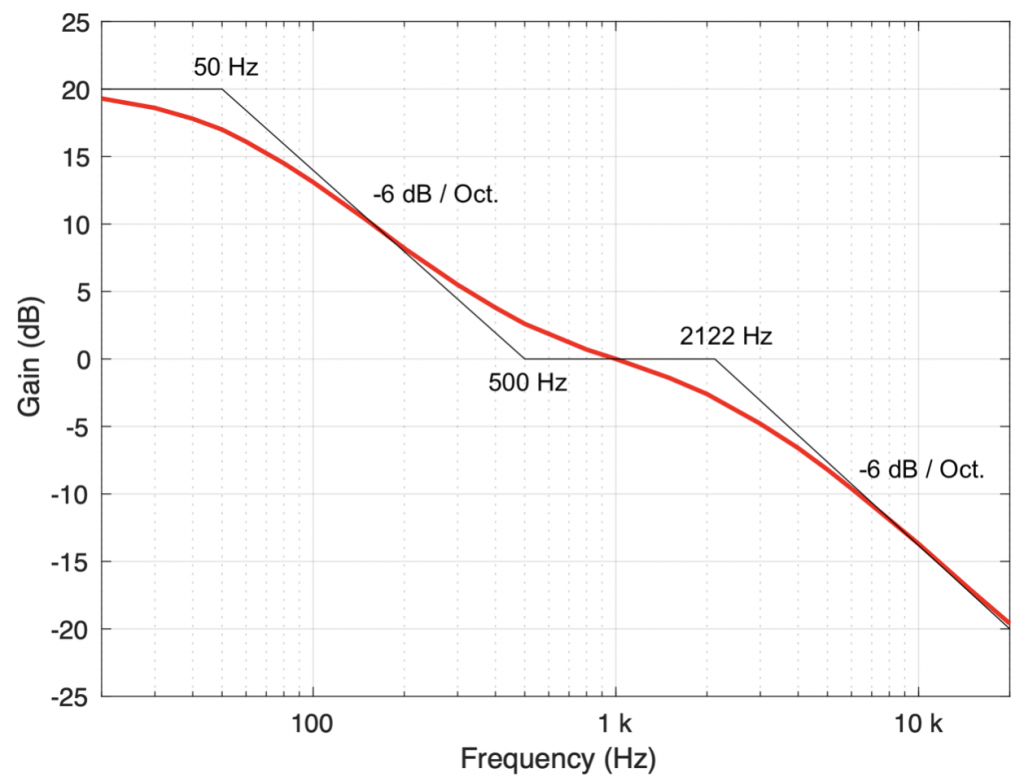
It may be of interest to note that typical descriptions of the RIAA equalisation filter define the transition points as time constants instead of frequencies. So, instead of 50 Hz, 500 Hz, and 2122 Hz (as shown in the response plots), the points are listed as 3180 µs (microseconds), 318 µs, and 75 µs instead. If you wish to convert a time constant (Tc) to the equivalent frequency (F), you can use the equation below.
F = 1 / (2 π Tc)
Mono to Stereo
In Edison’s first cylinder recordings, the needle vibrated up and down instead of left and right to record the audio signal. This meant that the groove cut into the surface of the tin foil was varying in depth, and therefore in width, as shown in the figure below.
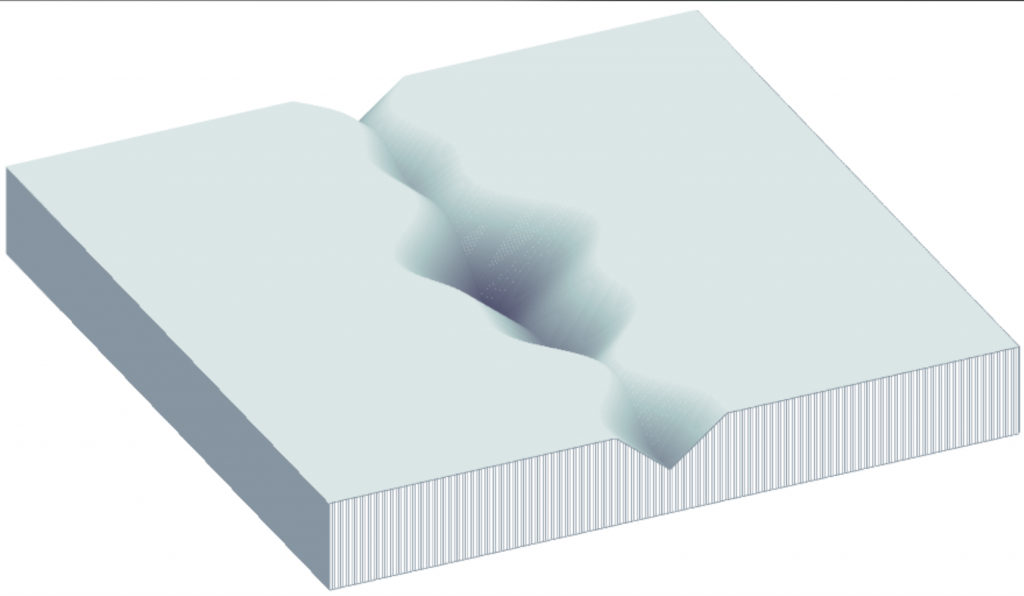
There are some disadvantages to this system, such as the risk of the needle slipping out of the groove when it is too shallow, or suffering from excessive wear if the groove is too deep. In addition, any vertical variation in the recording surface (such as a cylinder that is not quite round, or mechanical vibrations in the player caused by footsteps in the room) becomes translated into unwanted noises upon playback. (3)
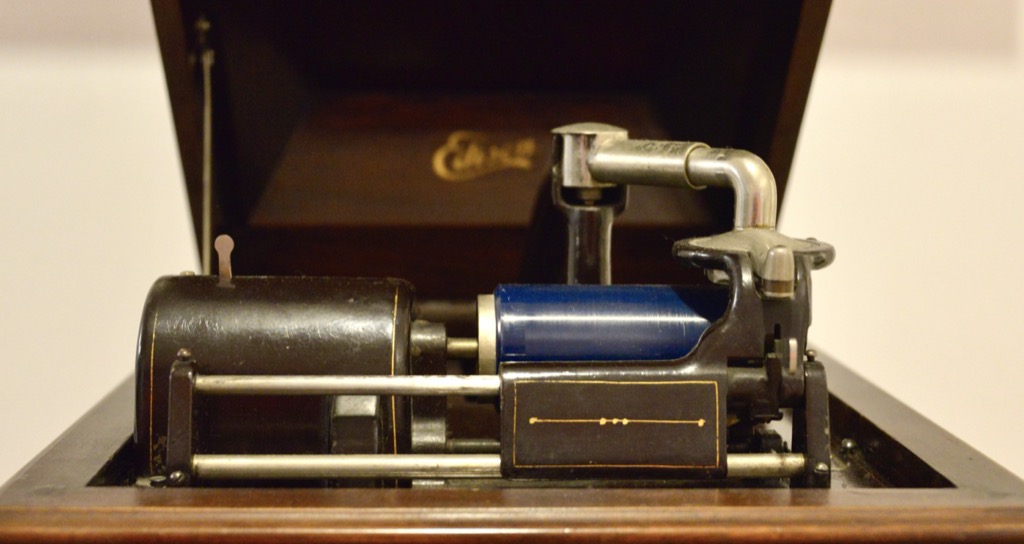
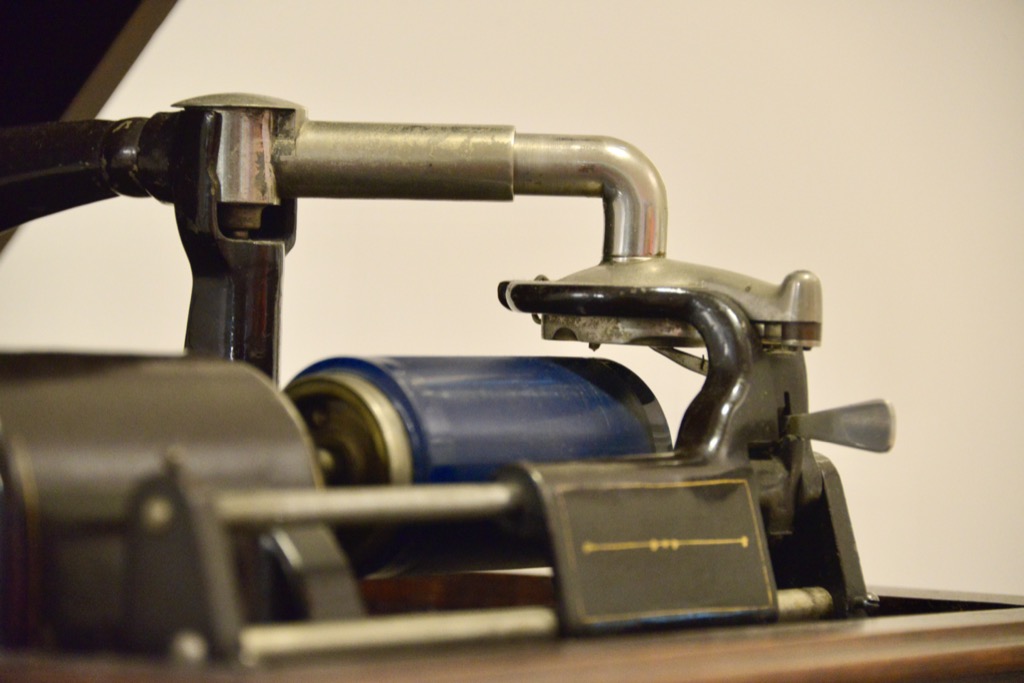
Berliner’s Gramophone used a different system, where the needle vibrated sideways instead. This lateral cut system produced a groove on the disc with a constant depth, thus avoiding some of the problems incurred by the vertical cut recording system.
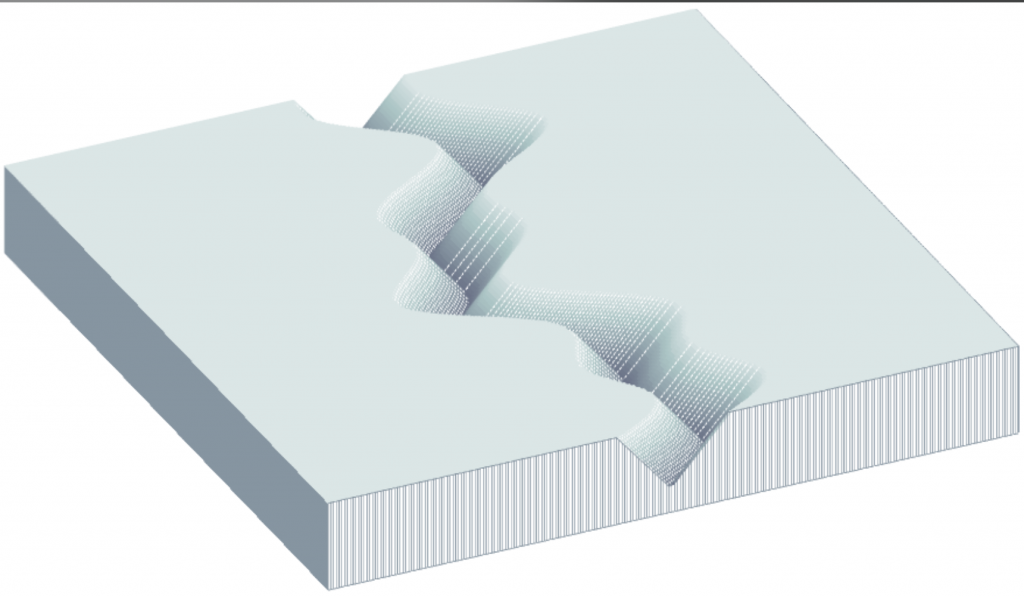
However, both of these systems were only capable of recording a single channel of audio information. In order to capture 2-channel stereo audio (invented by Alan Blumlein in 1931) the system had to be adapted somehow. The initial challenge was to find a way of making a disc player that could reproduce two channels of stereo audio, while still maintaining compatibility with lateral-cut discs.
The solution was to rotate the modulation direction by 45 degrees, so the two walls of the groove are used to record the two separate audio channels. This means that the stylus moves in two (theoretically independent) axes as shown in the figure below. When the same signal is applied to both channels (better known as a “dual-mono” or “in-phase” signal), then the stylus moves upwards for the left while moving downwards for the right channel (or down-left & up-right), for example. This means that signals that are identical in both channels move the stylus laterally, exactly as in earlier monophonic discs. (For a more correct explanation of this movement, see this webpage)

As a result, if you look at the groove in a modern two-channel stereo LP, it appears first glance that it simply wiggles left-to-right. However, if you inspect the same groove with extreme magnification, you can see that the modulations in the two sidewalls of the groove are slightly different, since the audio signals on the left and right channels are not identical.
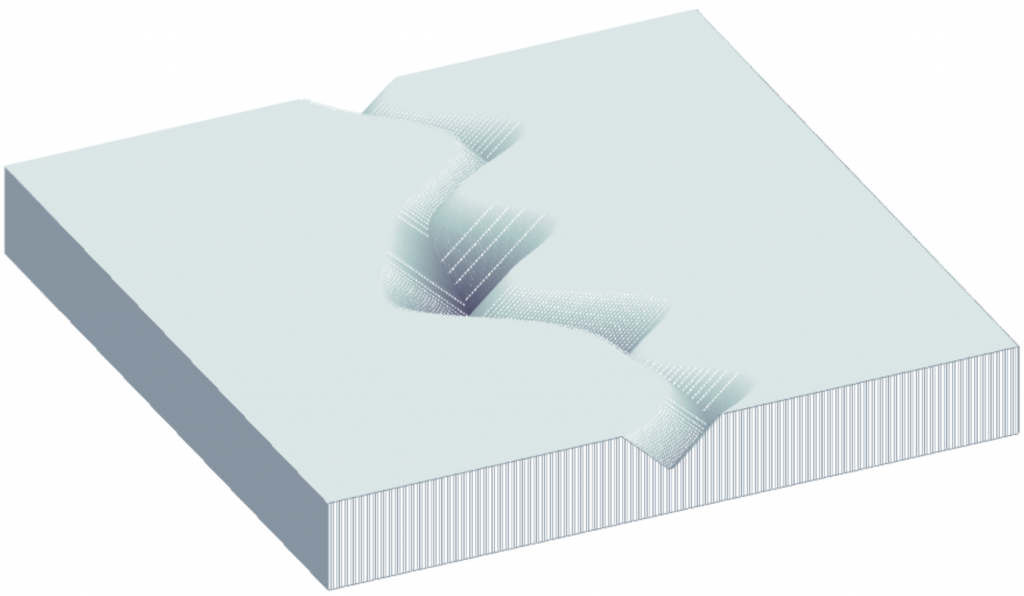
Footnotes
- Some authors reserve the term “stylus” for the device that is used to cut the groove during mastering, and the term “needle” for the device used to play a phonographic record. However, I’ll use the two terms interchangeably in this series.
- See the Manual of Analogue Sound Restoration Techniques (2008), by Peter Copeland
- Some 78 RPM discs use a vertical cutting system as well, including those made by Edison Disc Records and Pathé.
On to Part 3
Turntables and Vinyl: Part 1
Lately, a large part of my day job has been involved with the Beogram 4000c project at Bang & Olufsen. This turned out to be pretty fun, because, as I’ve been telling people, I’m old enough that many of my textbooks have chapters about vinyl and phonographs, but I’m young enough that I didn’t have to read them, since vinyl was a dying technology in the 1990’s.
So, one I the things I’ve had to do lately is to go back and learn all the stuff I didn’t have to do 25 years ago. In the process, I’ve wound up gathering lots of information that might be of interest to someone else, so I figured I’d collect it here in a multi-part series on phonographs.
A warning: this will not be a tome on why vinyl is better than digital or why digital is better than vinyl. I’m not here to start any arguments or rail against anyone’s religious beliefs. If you don’t like some of the stuff I say here, put your complaints in your own website.
Also, if you’ve downloaded the Technical Sound Guide for the Beogram 4000c, then you’ll recognise a large portions of these postings as auto-plagiarism. Consider the TGS as a condensed version of this series.
A very short history
In 1856, Édouard-Léon Scott de Martinville invented a device based on the basic anatomy of the human ear. It consisted of a wooden funnel ending at a flexible membrane to emulate the ear canal and eardrum. Connected to the membrane was a pig bristle that moved with it, scratching a thin line into soot on a piece of paper wrapped around a rotating cylinder. He called this new invention a “phonautograph” or “self-writer of sound”.
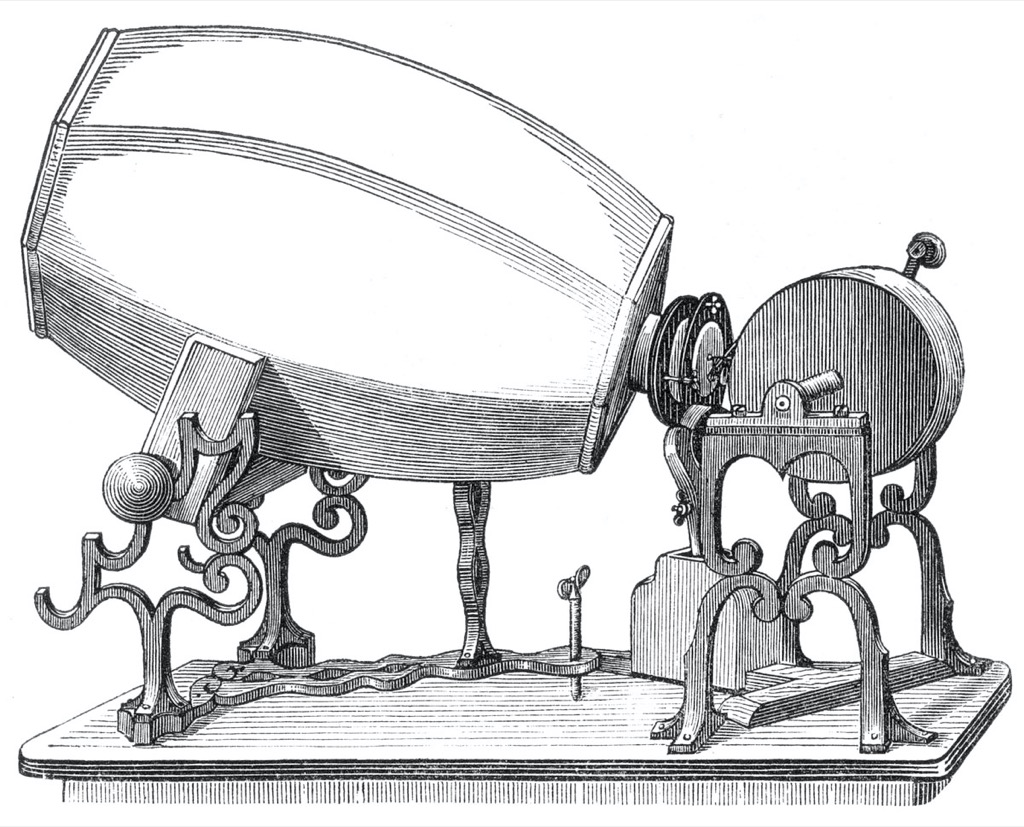
This device was conceived to record sounds in the air without any intention of playing them back, so it can be considered to be the precursor to the modern oscilloscope. (It should be said that some “recordings” made on a phonoautograph were finally played in 2008. See www.firstsounds.org for more information.) However, in the late 1870’s, Charles Cros realised that if the lines drawn by the phonoautograph were photo-engraved onto the surface of a metal cylinder, then it could be used to vibrate a needle placed in the resulting groove. Unfortunately, rather than actually build such a device, he only wrote about the idea in a document that was filed at the Académie des Sciences and sealed. Within 6 months of this, in 1877, Thomas Edison asked his assistant, John Kruesi, to build a device that could not only record sound (as an indentation in tin foil on a cylinder) but reproduce it, if only a few times before the groove became smoothed. (see “Reproduction of Sound in High-fidelity and Stereo Phonographs” (1962) by Edgar Villchur)
It was ten years later, in 1887, that the German-American inventor Emil Berliner was awarded a patent for a sound recording and reproducing system that was based on a groove in a rotating disc (rather than Edison’s cylinder); the original version of the system that we know of today as the “Long Playing” or “LP” Record.
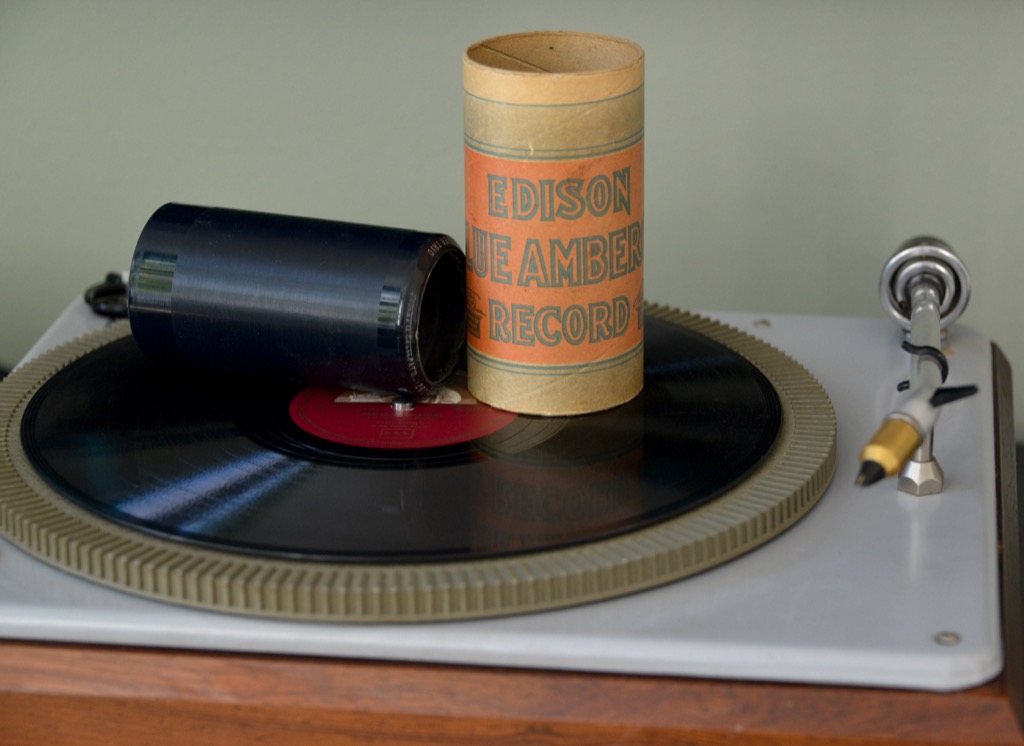
Early phonographs or “gramophones” were purely mechanical devices. The disc (or cylinder) was rotated by a spring-driven clockwork mechanism and the needle or stylus rested in the passing groove. The vibrations of the needle were transmitted to a flexible membrane that was situated at the narrow end of a horn that amplified the resulting sound to audible levels.
Magnets and Coils
In 1820, more than 30 years before de Martinville’s invention, the Danish physicist and chemist, Hans Christian Ørsted announced the first link made between electricity and magnetism: he had discovered that a compass needle would change direction when placed near a wire that was carrying an electrical current. Nowadays, it is well-known that this link is bi-directional. When current is sent through a wire, a magnetic field is generated around it. However, it is also true that moving a wire through a magnetic field will generate current that is proportional to its velocity.
Forward to Part 2: Physics